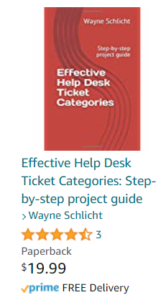
Implementing first contact resolution best practices can significantly improve your Help Desk’s resolution rate. First contact resolution is the percent of customer contacts that are solved by the Help Desk in the initial customer interaction without interruption. A successful resolution on the first contact means the issue is resolved before the customer’s initial support session has ended.
Why are first contact resolution best practices important?
First contact resolution is one of the most important Help Desk measurements and directly ties into staffing, cost, and customer satisfaction. For example, if you have a 70 percent FCR, that extra 30 percent is usually escalated to and handled by a senior Help Desk Agent or level 2 technical resource at a significantly higher hourly rate. It also means the Help Desk Agent is unavailable to take a new contract during that time when the Help Desk Agent must contact the customer a second time. Customer satisfaction decreases as the duration of time it takes to resolve this issue increases. It is important to track and analyze contacts that were not solved on the first contact to control staffing levels, reduce cost, and improve customer satisfaction.
First contact resolution best practices you should implement
Once your Help Desk has implemented a process of measuring First Contact Resolution, you will build a baseline of your overall team FCR average. Also, you will start to see some other trends developing. The first trend you will see is that your Help Desk will have agents with strong FCR averages and agents with FCR averages that need improvement. Additionally, you will see high and low FCR rates for specific ticket categories. Consider the below First Contact Resolution best practices and improvement ideas to improve your team, agent, and specific ticket categorization of FCR rates.
1. Implement Total Contact Ownership (TCO).
The total contact ownership process is based on whoever started the initial contact with the customer owns the ticket from the cradle to the grave. The Help Desk Agent will have a vested interest to ensure the customer’s issue is resolved versus just escalating it to another support team. If a ticket is escalated, the Help Desk agent will follow the resolution progress, understand how the issue was resolved, and update the knowledge base for the specific issue resolution steps. If the same type of issue occurs in the future, the agent will know exactly how to resolve the issue, and you will see FCR rates improve.
2. Leverage skill-based contact routing.
For a Help Desk with a smaller staff size, agents must have general support knowledge for almost every type of issue. For medium and large staffed Help Desks, agents develop intermediate and expert level knowledge for specific topics. By implementing contact criteria such as an interactive voice response (IVR) phone menu selection, contacts can be routed to Help Desk agents with the most applicable skill sets to resolve their issues. We call this skill-based routing. If this is correctly implemented, it will lead to a significant improvement in FCR.
3. Design a ticket categorization scheme.
A ticket categorization scheme is a method used by the Help Desk agent to classify the support ticket based on the specific issue being reported. The Help Desk agent will listen to the customer describing their issue and then assign an incident category that best matches the issue. Once a support ticket has an incident category assigned, many ticketing applications can present highly relevant knowledge solutions based on the category selected. Presenting relevant solutions to the Help Desk Agent during the diagnosis and troubleshooting phase will lead to higher resolution and FCR rates. If no relevant solutions exist in the knowledge base for the issue, one can be created once the solution is determined. This will assist agents in the future and ultimately improve FCR rates going forward.
reported. The Help Desk agent will listen to the customer describing their issue and then assign an incident category that best matches the issue. Once a support ticket has an incident category assigned, many ticketing applications can present highly relevant knowledge solutions based on the category selected. Presenting relevant solutions to the Help Desk Agent during the diagnosis and troubleshooting phase will lead to higher resolution and FCR rates. If no relevant solutions exist in the knowledge base for the issue, one can be created once the solution is determined. This will assist agents in the future and ultimately improve FCR rates going forward.
4. Review the caller’s ticket history.
Issues can develop as a result of change activity. Displaying the contact’s previous tickets can provide clues to what has recently happened to a customer’s technology. By presenting a summary of previous support tickets, Help Desk agents can better understand the customer’s issue and, if related, could help solve the current issue.
5. Create incident decision trees.
Troubleshooting some issues can take a great deal of time. Many Help Desks will reduce the troubleshooting resolution time and improve FCR rates by offering the agents a decision tree. A decision tree presents questions with answer selections for symptoms or attributes of the customer’s issue. When selecting the matching answer, the decision tree script will continue to narrow down the issue by asking additional questions. This will continue until, ultimately, a potential solution is presented. This is like the twenty questions game and is very helpful. However, creating one decision tree script for all issues would result in a huge complex decision tree. By creating smaller decision tree scripts with the starting point based on ticket classification, Help Desk Agents are more successful in finding the solution at a faster rate.
6. Focus your improvement efforts based on FCR trends.
Using the Pareto Principle against the tickets not resolved on the first contact, 20 percent of those issues will account for 80 percent of the tickets. In other words, most of the tickets will be related to a small number of category types. Export your support ticket data for all issues that could not be solved on the first contact. Group all these tickets by support ticket classification type. Arrange the sorting of the groups by highest to lowest occurrence. Focus on the highest occurring support tickets that could not be resolved on the first contact. Identifying a solution for these issues first will significantly reduce the volume in the future.
7. Give Help Desk agents appropriate access and tools.
Ensure your Help Desk Agents have the right tools and access to do their job. This sounds simple, but you would be surprised to find out that the Help Desk sometimes is not given the tools and access needed to fix the issue. The administrators of the system may not have delegated the rights to use the tool or provided the training. If this is the case, empowering the Help Desk agent with this ability will improve FCR rates and free up more expensive resources to do other work.
8. Encourage employee driven solutions.
Encourage your Help Desk agents to suggest solutions to improve FCR percentage. By asking Help Desk agents for their input, they will have a sense of ownership in the process. Since the agents are part of the support calls, they may have some good improvement ideas to share. Setting up a recognition program for good ideas will also encourage participation.
Leave a Reply